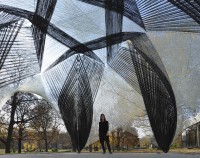ICD + ITKE
Research Pavilion
source: itkeuni-stuttgartde
Im November 2012 realisierten das Institut für Computerbasiertes Entwerfen (ICD) und das Institut für Tragkonstruktionen und Konstruktives Entwerfen (ITKE) der Universität Stuttgart einen temporären bionischen Versuchsbau aus faserbasiertem Verbundmaterial, der zusammen mit Studierenden im Rahmen einer einjährigen Forschungs- und Entwicklungszeit entworfen, geplant und ausgeführt wurde. An der Schnittstelle von Lehre und Forschung untersucht das Projekt die Übertragung biologischer Form- und Materialbildungsprinzipien der Außenskelette von Gliederfüßern (Arthropoden) als Ausgangspunkt für neue Konstruktionsformen in der Architektur.
Grundlage für dieses Projekt bildet die Entwicklung einer für das Bauwesen hoch innovativen Fertigungsmethode des robotischen Wickelns von Carbon- bzw. Glasfasern und die dazugehörigen computerbasierten Entwurfs- und Simulationsverfahren. Schwerpunkt des Entwurfs war es, die faserbasierte Struktur des biologischen Vorbilds mit faserverstärkten Kunststoffen abzubilden, deren Anisotropie von Beginn an in den computerbasierten Entwurfs- und Simulationsprozess zu integrieren und daraus neue tektonische Möglichkeiten für die Architektur abzuleiten. Die Integration der Methoden der Formgenerierung, der computerbasierten Simulation sowie robotischen Fertigung erlaubt es ebenfalls, eine hochleistungsfähige Strukturlogik zu entwickeln. Bei einer Spannweite des Pavillons von 8m gelang es eine Schalendicke von lediglich 4mm Laminatstärke zu realisieren.
.
.
.
.
.
.
.
source: itkeuni-stuttgartde
In November 2012 the Institute for Computational Design (ICD) and the Institute of Building Structures and Structural Design (ITKE) at the University of Stuttgart have completed a research pavilion that is entirely robotically fabricated from carbon and glass fibre composites. This interdisciplinary project, conducted by architectural and engineering researchers of both institutes together with students of the faculty and in collaboration with biologists of the University of Tübingen, investigates the possible interrelation between biomimetic design strategies and novel processes of robotic production. The research focused on the material and morphological principles of arthropods’ exoskeletons as a source of exploration for a new composite construction paradigm in architecture.
At the core of the project is the development of an innovative robotic fabrication process within the context of the building industry based on filament winding of carbon and glass fibres and the related computational design tools and simulation methods. A key aspect of the project was to transfer the fibrous morphology of the biological role model to fibre-reinforced composite materials, the anisotropy of which was integrated from the start into the computer-based design and simulation processes, thus leading to new tectonic possibilities in architecture. The integration of the form generation methods, the computational simulations and robotic manufacturing, specifically allowed the development of a high performance structure: the pavilion requires only a shell thickness of four millimetres of composite laminate while spanning eight metres.


